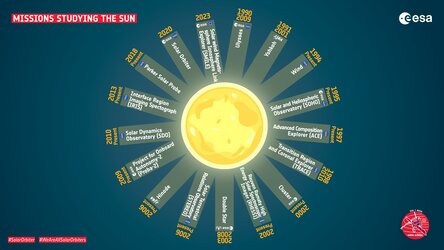Accept all cookies Accept only essential cookies See our Cookie Notice

About ESA
The European Space Agency (ESA) is Europe’s gateway to space. Its mission is to shape the development of Europe’s space capability and ensure that investment in space continues to deliver benefits to the citizens of Europe and the world.
Highlights
ESA - United space in Europe
This is ESA ESA facts Member States & Cooperating States Funding Director General Top management For Member State Delegations European vision European Space Policy ESA & EU Space Councils Responsibility & Sustainability Annual Report Calendar of meetings Corporate newsEstablishments & sites
ESA Headquarters ESA ESTEC ESA ESOC ESA ESRIN ESA EAC ESA ESAC Europe's Spaceport ESA ESEC ESA ECSAT Brussels Office Washington OfficeWorking with ESA
Business with ESA ESA Commercialisation Gateway Law at ESA Careers Cyber resilience at ESA IT at ESA Newsroom Partnerships Merchandising Licence Education Open Space Innovation Platform Integrity and Reporting Administrative Tribunal Health and SafetyMore about ESA
History ESA Historical Archives Exhibitions Publications Art & Culture ESA Merchandise Kids Diversity ESA Brand CentreLatest
Space in Member States
Find out more about space activities in our 23 Member States, and understand how ESA works together with their national agencies, institutions and organisations.
Science & Exploration
Exploring our Solar System and unlocking the secrets of the Universe
Go to topicAstronauts
Missions
Juice Euclid Webb Solar Orbiter BepiColombo Gaia ExoMars Cheops Exoplanet missions More missionsActivities
International Space Station Orion service module Gateway Concordia Caves & Pangaea BenefitsLatest
Space Safety
Protecting life and infrastructure on Earth and in orbit
Go to topicAsteroids
Asteroids and Planetary Defence Asteroid danger explained Flyeye telescope: asteroid detection Hera mission: asteroid deflection Near-Earth Object Coordination CentreSpace junk
About space debris Space debris by the numbers Space Environment Report In space refuelling, refurbishing and removingSafety from space
Clean Space ecodesign Zero Debris Technologies Space for Earth Supporting Sustainable DevelopmentLatest
Applications
Using space to benefit citizens and meet future challenges on Earth
Go to topicObserving the Earth
Observing the Earth Future EO Copernicus Meteorology Space for our climate Satellite missionsCommercialisation
ESA Commercialisation Gateway Open Space Innovation Platform Business Incubation ESA Space SolutionsLatest
Enabling & Support
Making space accessible and developing the technologies for the future
Go to topicBuilding missions
Space Engineering and Technology Test centre Laboratories Concurrent Design Facility Preparing for the future Shaping the Future Discovery and Preparation Advanced Concepts TeamSpace transportation
Space Transportation Ariane Vega Space Rider Future space transportation Boost! Europe's Spaceport Launches from Europe's Spaceport from 2012Latest
ESA's science fleet of Solar System explorers
Thank you for liking
You have already liked this page, you can only like it once!
Note: This image was updated on 9 April 2025 to reflect updated mission information.
ESA's science missions have been exploring our planetary neighbourhood to tackle the big questions that help to put Earth in context, to understand a planet's interaction with its host star, and to search for habitable worlds. With more and more planets found in solar systems beyond ours, understanding our own cosmic neighbourhood has never been so important.
We have sent spacecraft to Earth’s nearest planetary neighbours – Mars and Venus – to understand why they evolved so differently, with the upcoming ExoMars rover soon to drill below the Red Planet's surface to see if there is any evidence of past life preserved underground. In the next decade we’ll be unlocking the secrets of the innermost planet, Mercury, and sending a spacecraft to Jupiter and its ocean-bearing moons – both key to understanding Solar System evolution.
The successes of our earlier missions – including landing on Titan and orbiting and landing on a comet – form part of ESA's science and technology legacy, feeding into the next generation of Solar System missions. Even missions that have completed their in-flight operations still yield new scientific discoveries decades after, thanks to their vast data archives available to researchers worldwide.
This graphic showcases the current status of ESA's space science exploration missions in the Solar System, including upcoming collaborative missions with partner agencies (e.g. Smile in collaboration with China) and the so-called missions of opportunity – missions led by other agencies but which ESA and its member states participate (e.g. Martian Moons Exploration, MMX, led by JAXA). For a complete breakdown of all science missions, see our mission navigator.
This portfolio of past, present and future missions shows the importance of long-term planning to realise the missions that investigate fundamental science questions, and to ensure the continued development of innovative technology, inspiring new generations of European scientists and engineers. For example, Rosetta, well-known for its recent series of inspirational successes, was first conceived several decades ago, in the 1980s. Where do we want to be in twenty or thirty years time?
In the graphic, date ranges refer to launch and completion of in-flight operations. For future missions the foreseen launch date is indicated.
ESA also has a fleet of space science missions observing the Universe across the electromagnetic spectrum. Discover them here.
-
CREDIT
ESA -
LICENCE
CC BY-SA 3.0 IGO or ESA Standard Licence
(content can be used under either licence)

ESA's fleet in the Solar System poster 2017

ESA science missions

Polishing Smile’s solar panels

ESA Fleet In Solar System poster 2013















 Germany
Germany
 Austria
Austria
 Belgium
Belgium
 Denmark
Denmark
 Spain
Spain
 Estonia
Estonia
 Finland
Finland
 France
France
 Greece
Greece
 Hungary
Hungary
 Ireland
Ireland
 Italy
Italy
 Luxembourg
Luxembourg
 Norway
Norway
 The Netherlands
The Netherlands
 Poland
Poland
 Portugal
Portugal
 Czechia
Czechia
 Romania
Romania
 United Kingdom
United Kingdom
 Slovenia
Slovenia
 Sweden
Sweden
 Switzerland
Switzerland
























